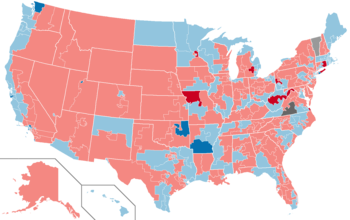United States House of Representatives elections, 2000
|
|
||||||||||||||||||||||||||||||||||||||||||||
|
||||||||||||||||||||||||||||||||||||||||||||
|
||||||||||||||||||||||||||||||||||||||||||||
|
|
||||||||||||||||||||||||||||||||||||||||||||
|
Results:
Democratic hold
Democratic pickup
Republican hold
Republican pickup
Independent hold
Independent pickup
|
||||||||||||||||||||||||||||||||||||||||||||
|
||||||||||||||||||||||||||||||||||||||||||||
The Elections for the United States House of Representatives on November 7, 2000 coincided with the election of George W. Bush as President. The Republican Party narrowly lost seats to the Democratic Party, reducing their majority slightly to just three seats.
This marked the third time in a row that Democrats gained on the majority Republicans. Like the 1990 election, both major parties lost votes to the Libertarian Party, the Green Party and other third parties in addition to independent candidates. The resulting balance of seats, 221 to 212, was the slimmest majority held by either party since 1952.
Future President Barack Obama unsuccessfully ran for the Democratic nomination to represent Illinois's 1st congressional district.
...
Wikipedia



